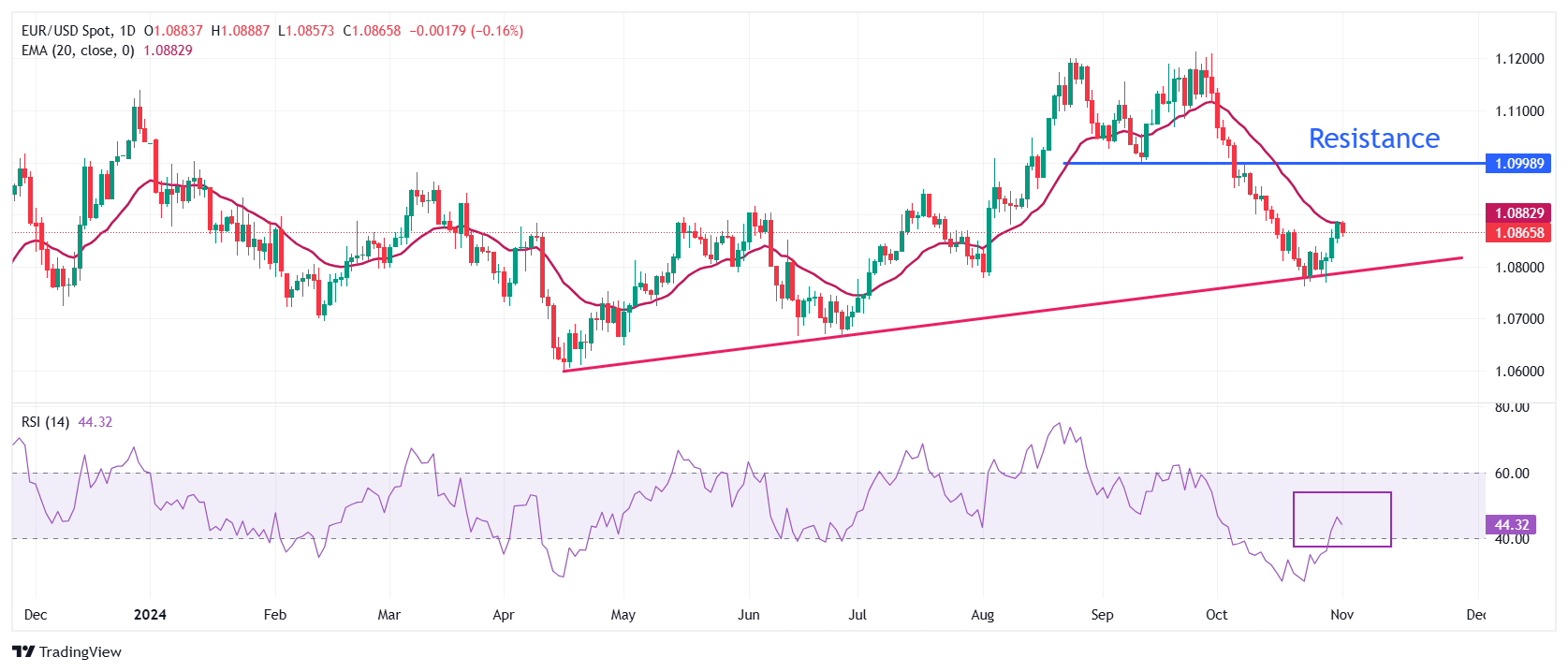EUR/USD Declines As Traders Brace For US Nonfarm Payrolls Data
- EUR/USD falls as investors stay cautious ahead of the US official employment and the Manufacturing PMI data for October.
- The US presidential election could potentially inject volatility into the major pair as a Trump win could hurt the Eurozone’s export sector.
- Market expectations for large rate cuts from the ECB in December have diminished amid a pickup in inflation and higher growth.
EUR/USD slumps from a fresh two-week high near 1.0890 in European trading hours on Friday. The major currency pair declines as the US Dollar (USD) bounces back amid caution ahead of the release of the United States (US) Nonfarm Payrolls (NFP) and the ISM Manufacturing Purchasing Managers’ Index (PMI) data for October, which will be published in the New York session.
Economists expect the US economy to have added 113K fresh payrolls, significantly lower than the 254K increase seen in September. The Unemployment Rate is expected to have remained steady at 4.1%.
Investors will pay close attention to the employment data as it will significantly influence market expectations for the Federal Reserve (Fed) interest rate path. Recent commentary from Fed officials indicates that the central bank is more focused on reviving labor market strength after gaining confidence about inflation returning to the bank’s target of 2%.
Traders are fully pricing in a 25 basis points (bps) rate cut at the Fed’s next meeting on Thursday, and the NFP is unlikely to alter this outlook unless there is a huge surprise. However, the data could have implications for the Fed’s December meeting: higher-than-expected payroll data would point to improving labor market conditions – which could dampen Federal Reserve (Fed) rate cut bets –, while weak employment numbers would boost them.
Investors will also focus on the Average Hourly Earnings data for October, a key measure of wage growth, and the Manufacturing PMI data from both the ISM and S&P Global.
As for earnings, the month-on-month wage growth measure is expected to have grown by 0.3%, slower than 0.4% in September, with annual figures rising steadily by 4%.
The ISM Manufacturing PMI is seen at 47.6 in October, up slightly from 47.2 in September, suggesting that the contracting trend is intact but its pace has slowed. The final estimate of the S&P Global Manufacturing PMI is expected to remain unchanged from the 47.8 flash reading.
Daily digest market movers: EUR/USD falls as US Dollar rebounds
- EUR/USD faces a slight correction from near 1.0890 due to US Dollar’s recovery. However, the Euro’s (EUR) performance against other peers has remained firm on multiple tailwinds. Faster-than-expected Eurozone Gross Domestic Product (GDP) growth in the third quarter of the year and hotter-than-forecasted inflation have forced traders to reassess bets supporting European Central Bank (ECB) larger-than-usual rate cut bets for the December policy meeting.
- Eurostat showed on Wednesday that the Eurozone economy expanded by 0.9% compared to the same quarter of the preceding year, accelerating from the 0.6% growth in the previous quarter, mainly due to a surprise performance of the German economy, according to flash estimates. This has diminished the immediate risks of an economic downturn, although the outlook remains uncertain ahead of the US presidential election, which will take place on Tuesday.
- Eurozone exports are expected to be hit if former President Donald Trump wins against current Vice President Kamala Harris. Trump has vowed for a universal tariff of 10% on all nations – except China, which is expected to face much higher tariffs – to boost in-house manufacturing capabilities.
- Another factor supporting the EUR is the recent inflation uptick in the Eurozone. The preliminary Harmonized Index of Consumer Prices (HICP) accelerated more than expected to 2% in October from 1.7% in September.
Technical Analysis: EUR/USD struggles to climb above 200-day EMA
(Click on image to enlarge)
EUR/USD falls after posting a fresh two-week high around 1.0890 on Thursday. The major currency pair faces selling pressure near the 20-day Exponential Moving Average (EMA), which trades at around 1.0900. EUR/USD had previously rebounded sharply after gaining a firm footing near the upward-sloping trendline around 1.0750, which is plotted from the April 16 low at around 1.0600.
The 14-day Relative Strength Index (RSI) climbs to near 42.00 after staying in the 20.00-40.00 range for almost a month, suggesting that the bearish momentum is waning.
Looking up, the shared currency pair could rise to near the September 11 low around 1.1000 after breaking above the 200-day EMA around 1.0900. On the downside, the October 23 low of 1.0760 will be the key support area.
More By This Author:
AUD/USD Consolidates Around 0.6550 As Focus Shifts To US NFPEUR/USD Holds Onto Gains After Robust Eurozone GDP Growth Supports Euro
EUR/USD Consolidates Ahead Of Flash Eurozone-US Q3 GDP, German Inflation
Disclaimer: Information on this article contains forward-looking statements that involve risks and uncertainties. Markets and instruments profiled on this page are for informational purposes ...
more



